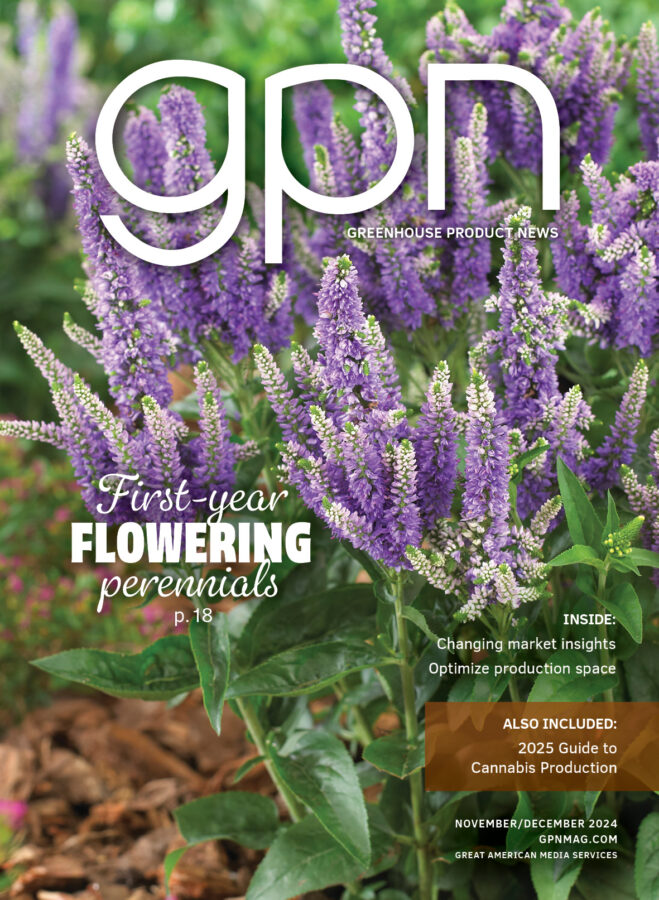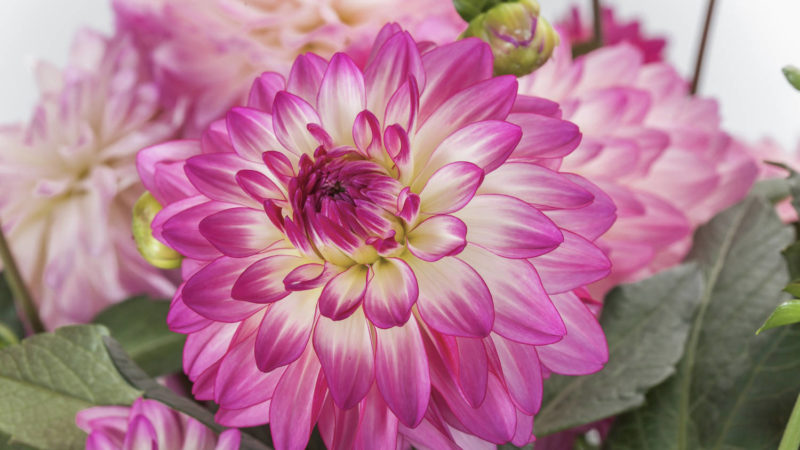
Culture Report: Dahlia ‘Sincerity’
There are three words to describe ‘Sincerity’ dahlia: Big, bold and beautiful. Dense, naturally well-branched plants make the perfect backdrop for the showy blooms. ‘Sincerity’ is a picture-perfect choice for the landscape and high-end patio containers. Give it a try with these easy culture tips.
PROPAGATION
Stick cuttings into 105-cell propagation trays or larger. Expect root emergence in eight to 10 days. Rooting hormone is not recommended, but bottom heat for the first three weeks will help ensure even, strong rooting. 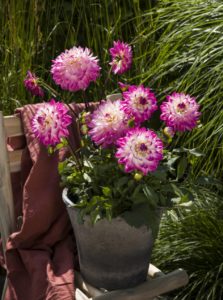 Media temperatures of 70 to 74° F are recommended and then low them to hold and tone cuttings. Air temperatures between 72 to 74° F during the day and 70 to 72° F at night are recommended.
Media temperatures of 70 to 74° F are recommended and then low them to hold and tone cuttings. Air temperatures between 72 to 74° F during the day and 70 to 72° F at night are recommended.
Apply enough mist upon stick to rehydrate the cuttings and keep them from wilting — they should rehydrate within 24 hours. Cuttings that are allowed to wilt heavily after stick will callus unevenly and delay rooting. CapSil (spray adjuvant) can be sprayed on the cuttings at 2 to 4 oz. /100 gal within one to two days of sticking to help rehydration. Misting can be reduced after cuttings have rehydrated.
Dahlias are facultative short day plants so during propagation it is important to provide long days (14 hours) either through day length extension or night interruption to prevent premature budding that can delay rooting. For the first two weeks after sticking or until roots form, a daily light integral (DLI) of 4 to 6 mols/ day is recommended and then light levels can be increased to greater than 12 mols/day. ‘Sincerity’ should be fully rooted in about four weeks in a 105-cell tray.
Recommended media pH and EC is 5.8 to 6.2 and 1.4 to 2.0, respectively (via PourThru method). Fertilization should begin at 100-ppm nitrogen when roots become visible. Rates can be increased up to 200-ppm nitrogen after roots are well developed. It’s best to use primarily Cal-Mag Plus (calcium nitrate + magnesium nitrate) fertilizers in propagation to prevent unwanted stretch. Pinching is usually not needed and not advised.
‘Sincerity’ has a moderately vigorous habit and may require a PGR treatment in propagation to reduce unwanted internode elongation. If needed to control growth after rooting, sprays of B-Nine WSG (1,500 ppm) are usually sufficient. A tank-mix spray of Florel (350 to 500 ppm) + B-Nine WSG (1,500 ppm) can also be used to control growth and further improve branching. Do not spray Florel on stressed or weak cuttings. For all sprays listed above, the mist should be off for a minimum of one hour for the PGR to absorb into the leaf tissue.
FINISH
Transplant directly into the finished container. We recommend one plant per pot in a gallon (2.5 quart) container; for larger containers, such as 10- or 12-inch pots, use two to three plants per pot. Plant the liner relatively deep in the container. Dahlias need deep and sturdy planting to provide good support and balance in the pot for the maturing plants.
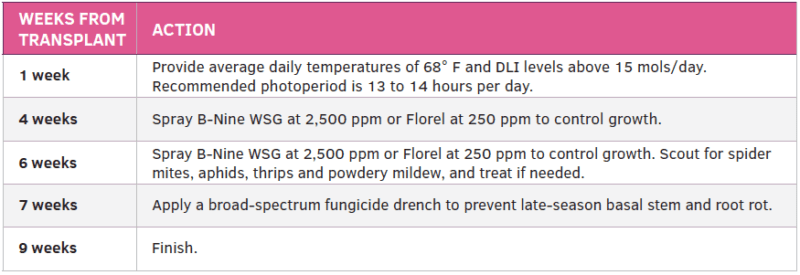
Provide warm temperatures early-on in finishing to allow plants to establish after transplant. ‘Sincerity’ grows best under moderately warm temperatures. Avoid extreme heat stress, especially under relatively high light intensities. Day temperatures between 66 to 68° F and night temperatures between 64 to 66° F are suggested. Average daily temperature is ideal between 69 to 71° F.
Day extension lighting is beneficial to 14 hours or use night interruption. The ideal photoperiod during finishing to provide the correct balance between vegetative growth and flower formation is between 13 and 14 hours. Growing under very short natural days (< 12 hours) will result in short plants, fast flowering, and poor rooting from tuber formation. Conversely, growing under too long of a day length (>14 hours) for the entire crop will severely delay flowering and result in a large vegetative plant with little flowering. Recommended light intensity during finishing is 4,000 to 6,000 foot-candles and a DLI of 16 to 18 mols/day.
Using the PourThru method, media EC and pH should be kept between 2.3 to 3.2 and 5.8 to 6.2, respectively. We recommend fertilizing with 200- to 250-ppm nitrogen. Pinching is not necessary and will delay flowering by one week (see Figure 1). Without pinching, ‘Sincerity’ still produces lots of buds for fast secondary flowering due to its naturally branching habit. The long lasting flowers will cover plants with color.
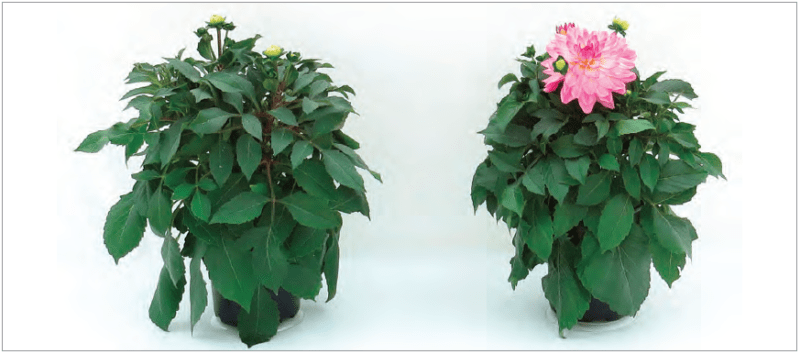
‘Sincerity’ has a sturdy, well-branched habit and benefits from moderate PGR treatments during finishing. Sprays of B-Nine WSG at 2,500 ppm can be used at four weeks and six weeks after transplant to help control growth. Alternatively, sprays of Florel at 250 ppm at four weeks and five-and-a-half to six weeks after transplant will also provide control. The Florel sprays will also help prevent late-season flower peduncle stretch (see Figure 2). A Bonzi drench at 2 to 4 ppm can be used to hold plants for sale at the end of production. On average, ‘Sincerity’ grown in 1-gallon containers finish in eight to nine weeks after transplant. Larger containers require longer finish time (see Table 2).
Scout and treat for a range of common insects including aphids, spider mites, thrips and leaf miners. Apply preventive controls for diseases including Botrytis, powdery mildew and basal stem rot. For post-harvest protection from ethylene damage during transport, we recommend spraying Chrysal Alesco two days before shipping finished plants to delay senescence and keep dahlias looking fresher longer.


 Video Library
Video Library 


















